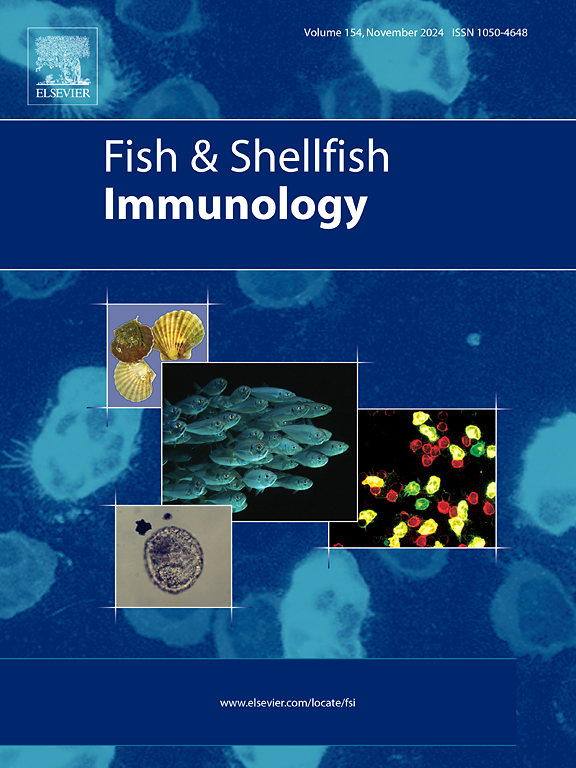Two homologous genes encoding interleukin (IL)-34 in the common carp (Cyprinus carpio L.): Roles in inflammatory modulation and anti-bacterial defense
IF 4.1
2区 农林科学
Q1 FISHERIES
引用次数: 0
Abstract
In mammals, interleukin 34 (IL-34) is a ligand for macrophage colony-stimulating factor receptor (M-CSFR), promoting inflammatory responses and inducing the synthesis and secretion of various cytokines. However, studies on its function in lower vertebrates is limited, and its evolutionary relationship with homologous molecules in mammals remains unclear. In this study, two IL-34-encoding genes were cloned and identified in common carp (Cyprinus carpio L.), designated as CcIL-34A and CcIL-34B, with an amino acid sequence similarity of 77.7 %. Gene synteny analysis revealed that the IL-34 gene loci are relatively conserved, and both are located downstream of SF3B3. The expression patterns of CcIL-34s were analyzed using qRT-PCR, and this showed that they are expressed across all tested tissues, with higher levels in the liver, spleen, and head kidney and lower levels in the gills and intestines. Following infection with Aeromonas hydrophila, the mRNA expression levels of CcIL-34s in the gills, head kidney, intestines, and spleen were significantly upregulated. Immunofluorescence was also employed to assess changes in CcIL-34 protein expression, showing a significant increase in carp spleens 24 h after A. hydrophila infection, suggesting that CcIL-34s contribute to host defense against this bacterium. To investigate the immunological function of IL-34 in vivo, pc-CcIL-34A and pc-CcIL-34B eukaryotic expression plasmids were constructed and injected intramuscularly into fish. Five days after injection, the expression levels of inflammation-related cytokines in the head kidney and spleen were significantly altered. Furthermore, 24 h post-A. hydrophila infection, the bacterial loads in the liver, spleen, and kidneys were significantly reduced. Ten days post-infection, the survival rates in the groups with CcIL-34A and CcIL-34B overexpression were 40 % and 36.7 %, respectively, compared to 16.7 % in the control group. These findings suggest that CcIL-34s are involved in modulating inflammatory responses, enhancing the immune response, and improving survival rates in fish following bacterial infection, thus supporting the potential use of IL-34 molecules in aquaculture.
鲤鱼(Cyprinus carpio L.)中编码白细胞介素(IL)-34 的两个同源基因:在炎症调节和抗菌防御中的作用。
在哺乳动物中,白细胞介素 34(IL-34)是巨噬细胞集落刺激因子受体(M-CSFR)的配体,可促进炎症反应并诱导各种细胞因子的合成和分泌。然而,对其在低等脊椎动物中功能的研究有限,其与哺乳动物中同源分子的进化关系也不清楚。本研究在鲤鱼(Cyprinus carpio L.)中克隆并鉴定了两个编码 IL-34 的基因,分别命名为 CcIL-34A 和 CcIL-34B,其氨基酸序列相似度为 77.7%。基因合成分析表明,IL-34 基因位点相对保守,且均位于 SF3B3 下游。利用 qRT-PCR 分析了 CcIL-34s 的表达模式,结果表明它们在所有测试组织中都有表达,其中肝脏、脾脏和头肾中的表达水平较高,而鳃和肠中的表达水平较低。感染嗜水气单胞菌后,鳃、头肾、肠道和脾脏中 CcIL-34s 的 mRNA 表达水平显著上调。免疫荧光也用于评估 CcIL-34 蛋白表达的变化,结果显示鲤鱼脾脏在感染嗜水气单胞菌 24 小时后 CcIL-34 蛋白表达明显增加,这表明 CcIL-34s 有助于宿主抵御这种细菌。为了研究 IL-34 在体内的免疫功能,我们构建了 pc-CcIL-34A 和 pc-CcIL-34B 真核表达质粒,并将其肌肉注射到鱼体内。注射五天后,头肾和脾脏中炎症相关细胞因子的表达水平发生了显著变化。此外,感染鳗鲡后 24 小时,肝脏、脾脏和肾脏中的细菌量明显减少。感染后十天,CcIL-34A 和 CcIL-34B 过表达组的存活率分别为 40% 和 36.7%,而对照组为 16.7%。这些研究结果表明,CcIL-34s 参与调节炎症反应、增强免疫反应和提高细菌感染后鱼类的存活率,从而支持 IL-34 分子在水产养殖中的潜在应用。
本文章由计算机程序翻译,如有差异,请以英文原文为准。
求助全文
约1分钟内获得全文
求助全文
来源期刊

Fish & shellfish immunology
农林科学-海洋与淡水生物学
CiteScore
7.50
自引率
19.10%
发文量
750
审稿时长
68 days
期刊介绍:
Fish and Shellfish Immunology rapidly publishes high-quality, peer-refereed contributions in the expanding fields of fish and shellfish immunology. It presents studies on the basic mechanisms of both the specific and non-specific defense systems, the cells, tissues, and humoral factors involved, their dependence on environmental and intrinsic factors, response to pathogens, response to vaccination, and applied studies on the development of specific vaccines for use in the aquaculture industry.
 求助内容:
求助内容: 应助结果提醒方式:
应助结果提醒方式:


